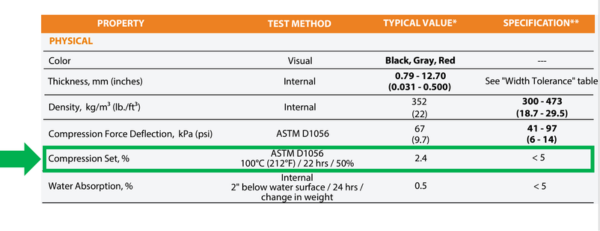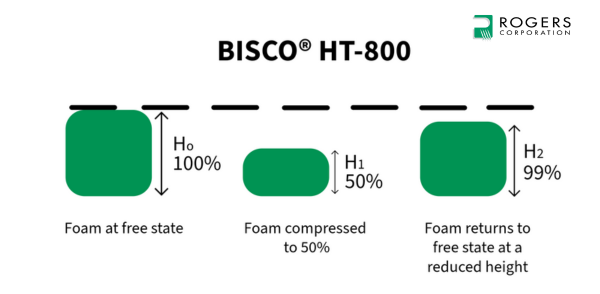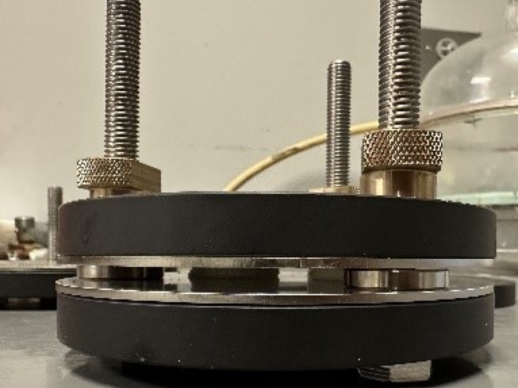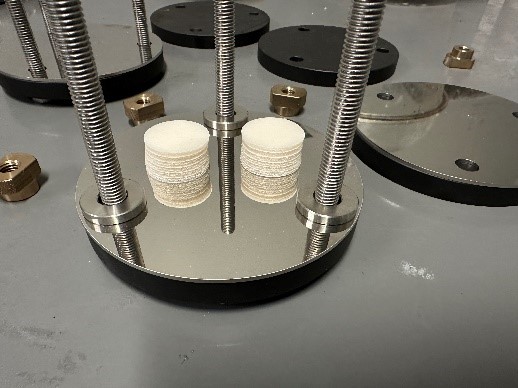
Published
by Rogers Corporation
Elastomeric Material Solutions
You’ve probably seen compression set values, or C-set, on a technical data sheet for an elastomeric material, but have you ever wondered what those values mean?
- Why is compression set important?
- Is a lower compression set value better?
- In what applications is it important to consider compression set?
Let's review the essential information you need to know about compression set and its importance to your application design.
What Exactly is Compression Set?
Compression set is an indicator of how a material behaves under certain compressed conditions and provides information about maintaining long-term performance over time. Specifically, compression set is a measure of how much a material will rebound after being compressed by a certain compression force/load, time, and temperature.
This is sometimes referred to as "memory of the foam" or "compression set resistance," which is the material's ability to go back to its original height after being compressed.
Below is a visual representation of compression set resistance.
The foam starts off at free state (uncompressed) and is then compressed to 50% of its original thickness. The load is released, and the material can relax. Then, it is measured to determine the final height, which is compared to the original height.
The difference between the foam's original height (Ho) and the new height after the compression is released (H2) is known as compression set.
Why Is Compression Set Important to Consider When Selecting a Material?
Compression set is a critical indicator of long-term performance. It determines how well a material can maintain an effective seal. This is especially important when an application needs a seal to last for prolonged periods or for use in an enclosure when the door is opened and closed often.
Here is another way to look at it — compression set indicates how well a material will retain its elastic properties under compression, or how well it endures a compressive load in an application.
Is a Low Compression Set Value Better for an Elastomeric Material?
For cellular foam materials, the lower the measured compression set percentage, the better the "recovery" of the material.
For example, let's look at the BISCO® HT-800 silicone foam TDS (Technical Data Sheets). Take note that compression set is expressed in a percentage.
Notice that BISCO® silicone HT-800 Medium Foam has a compression set typical value of 2% calculated under ASTM D1056, which means that over extended periods of compression, the material would rebound to 99% of its original height as seen in the illustration below. Questions about our math? Check out the calculations section below.
In comparison, another elastomeric material with a compression set of 20% would only rebound to 80% of its original height potentially resulting in reduced effectiveness in its sealing performance.
Why is a Low Compression Set Better for Long Term Sealing?
Low compression set is important in long term sealing for three reasons:
- Long-Term Reliability: Maintains effective sealing in critical applications
- Cost Efficiency: Reduces maintenance costs and downtime
- Enhanced Safety: Prevents leaks in crucial environments such as aerospace, automotive, and industrial applications
How is Compression Set Measured?
Compression set is measured using specific test methods based on the type of material. When reviewing a TDS and comparing different elastomers, it is important to know the following five conditions:
- Test method
- Compression amount
- Test duration
- Test temperature
- After compression relaxation time
ASTM D1056 calculates c-set based on the compressed height, and ASTM D3574 calculates it based on the uncompressed height. A material that reports a c-set of 2% by D1056, would report 1% by D3574. Silicones including BISCO materials are generally tested by D1056, while Urethanes including PORON materials are tested by D3574.
The compression set test for cellular materials includes a 50% compression at various temperatures depending on the material. Typically, it is conducted at room temperature (23 °C), intermediate temperature (70 °C), and high temperature (100 °C for silicone products). Since heat is an "accelerator" of compression set, an engineer would roughly relate these temperatures to their application.
The chart below details how different materials, including Rogers Corporation brands, have different testing methods, test specimen form factors, and final compression set calculations.
| Brand | PORON® Urethanes | BISCO® Silicones | ARLON® Industrial |
|---|---|---|---|
| Material Type | Polyurethane Foam | Silicone Foam | Silicone Sponge |
| Compression set method | ASTM D3574 | ASTM D1056 Class 1D |
ASTM D1056 Class 2D |
| Cell structure | Open | Modified Open/Closed | Closed |
| Sample minimum thickness | 0.375" | 0.250" | 0.500" |
| Sample size | 1.5" diameter | 1.0" diameter | 1.0" diameter |
| Test Compression amount of original thickness | 50% | 50% | 50% |
| Test Time | 22 hours ± 30 Minutes | 22 hours ± 30 Minutes | 22 hours ± 30 Minutes |
| Test Temperature | 70 °C | 100 °C | 100 °C |
| Time after releasing the load and testing thickness | 30 ± 5 minutes | 30 ± 5 minutes | 24 hours ± 15 minutes |
| Compression set, % Calculation | [(to-tl)/to]x100 | [(to-tl)/(to-ts)]x100 | [(to-tl)/(to-ts)]x100 |
Where:
to = original thickness
tl = thickness after recovery period
ts = spacer bar thickness
It is beneficial to understand the test method being used when comparing different materials, as test methods can vary, and it may not be an apples-to-apples comparison.
BISCO® Silicones use the most stringent test method, with a compression of 50%, temperature of 100°C, relaxation time of 30 minutes, and calculation (subtracting the spacer - more on this topic below). When superior compression set (low) is required for an application, your most reliable choice would be a BISCO Silicone cellular material.
PORON® Polyurethanes can be used in applications where lower temperatures are needed, but an excellent compression set value (low C-set) is still required.
ARLON® Industrial Sponges can be used in applications where high-temperature gasketing is needed, but a higher amount of compression set is allowed. This makes the sponge products fall into a general-purpose category.
What is a Spacer/Spacer Bar and Why is it Used in Compression Set?
A spacer bar is a calibrated shim which maintains the compressed thickness of a material during the test. Using a spacer ensures that the material is compressed by the right amount during the test.
Not all compression set tests use the spacer as part of the final compression set calculation. The use of a spacer in the calculation depends on the specific test method, the type of material being tested, and the standard being followed.
Subtracting the spacer from the equation increases the actual compression set value. In the case of BISCO silicone foam, this does not have an effect since the compression set is extremely low.
For example, the chart below shows the effect of spacer subtraction in an equation. The first column provides data without the spacer subtraction and the second column provides data with the spacer subtraction normally used for ASTM D1056:
| Without Spacer Subtraction | With Spacer Subtraction | |
|---|---|---|
| Original Thickness | 0.500 | 0.500 |
| Final Thickness | 0.490 | 0.490 |
| Spacer | 0.250 | 0.250 |
| Result | 2% | 4% |
As you can see, the calculation with the spacer subtracted results in a higher value. Thus, when reviewing compression set values, it is important to understand the calculation method used.
Now that we've explained the test methods, here is what an actual test looks like.
Compressed Fixture
Uncompressed Fixture
The uncompressed fixture shows a foam sample in its original thickness, while the compressed fixture shows the same foam sample compressed to a specific percentage of its original thickness between two plates. These images illustrate the “before” and “during” phases of the compression set test, showcasing how the foam material is tested.
What is Considered a "Good" Compression Set Value?
A compression set value of <5% is considered excellent for applications that must maintain effective sealing for extended periods of time.
Lower compressions set values of <5% are usually found with high-performance silicone and polyurethane foams such as BISCO silicones and PORON polyurethanes.
However, sometimes a higher compression set, such as 10-25% is sufficient and may be adequate for application sealing requirements.
Generally, if you want to maintain a long-term effective seal, look for materials with lower compression set values.
Are Compression Set and Stress Relaxation Related?
Compression set and stress relaxation are related but measure different aspects of a material's behavior during compression to seal.
Compression set is only defined for a specific load and time period to rebound once the material is released from the load.
Stress relaxation shows the material's ability to maintain a constant force over a period of time. The relationship between the initial force and the resulting loss over a long period of time is stress relaxation.
Key Points
Compression set resistance, often referred to as memory, is a critical consideration for application design.
Compression set resistance measures a material's ability to rebound after being compressed and is crucial for maintaining long-term performance, especially in applications requiring prolonged sealing.
A lower compression set value, expressed as a percentage, indicates better recovery of the material (resists permanent deformation or rebounds to original height).
If you need help determining what compression set you need for your application, our Rogers Technical Team can help! Rogers Corporation offers free samples of our materials to test material performance and fit. Speak with a Rogers Sales Engineer to get started.
Related Content
- Stress Relaxation and Why It's Important in Elastomeric Seals
- The Engineer's Toolkit: 8 Best Tools for Effective Material Selection
- Top 7 Unique Silicone Advantages You Can't Ignore
Published on Aug 08, 2024





